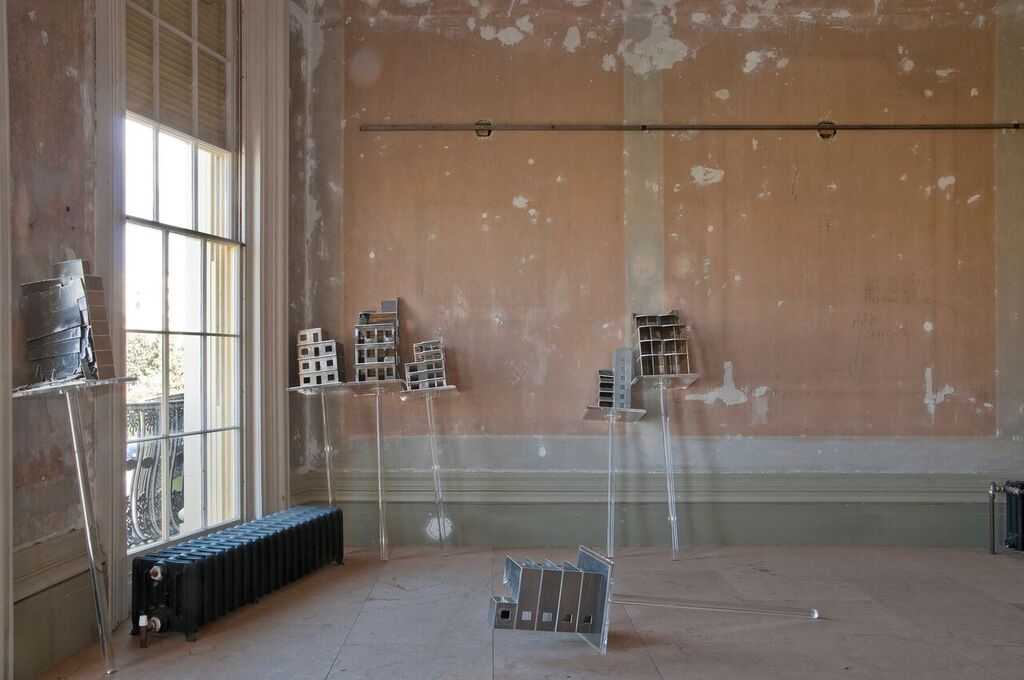Agnes Varda, the legendary eighty-six year-old Belgian filmmaker and artist, is putting the finishing touches to an installation. Towers of lurid plastic buckets and baskets, the pleasing wordplay of “Ping-Pong Tong Camping”, stained glass window panels of flip-flop frisbees, and the photo-puzzle of the Baccalaureate celebrations of naked boys on the beach: Varda’s new work revisits her famous film and memoir The Beaches of Agnes and embraces all the distortions and madness involved in the process of re-remembering.
We’re here in the University of Brighton Gallery on a tour of the Brighton Festival and the HOUSE commissions listening as Varda describes the piece as her “hymn to coloured-plastic”. Entitled Beaches, Beaches, it’s a celebration of the life of summer and all of the colours it proposes. A ludic homage to the bright paraphernalia of the “beach spectacle”, Varda’s installation resembles a half-remembered dream of some now-distant trip to the beach, giddily recalled as a hot explosion of colour and Vitamin D.
While Varda confesses to being a little disappointed to find that Brighton’s beach was a stretch of pebbles and not sand, these pebbles have their own hymn amongst the HOUSE commissions to counter the plastic-technicolour of Varda’s eccentric masterpiece. The meditative and mesmerising video work Relict Material by Amanda Loomes is a lyrical ode in light and sound and aggregate, to Brighton’s most commonplace “relict material”.
A relict is ‘a surviving remnant of a natural phenomenon’ and in Brighton it’s found in abundance on the coastline in the pebble-dash piled up by the tides.
Projected onto a screen of aggregate bricks and filmed (at points) in eights to reflect the pattern of the industry’s eight hour shifts, there is more love for pebbles, sand, aggregate and concrete in this fifteen-minute video than you might have believed possible and, through its sincerity and passion, it is infectious.
A relict is “a surviving remnant of a natural phenomenon” and in Brighton and Sussex it’s found in abundance on the coastline in the pebble-dash piled up by the tides. As the voices of the workmen in Loomes’s video tell us: “the aggregate that we dredge up is quite often the end of a riverbed from the ice age. The aggregate won’t have seen the light of day for millions of years, one hundred and fifty million years or more.”
Relict Material explores the huge scale of the marine aggregate industry, an industry still thriving to the west of Brighton along the coast in Shoreham, where they process Brighton’s relict pebbles in the production of concrete. The video is a meditation on time and labour and the slow movement of materials, as well as the forces of the natural world and industry.

Loomes presents a process in which the poetry of the Festival’s theme, Edge and Shift, and its creative possibility is subsumed by the tedious and repetitive reality of shift work. The video is stunningly poised between the visual richness of long, slow cinematic sequences and the grit and exactitude of an industrial process. However, Loomes might label her work as an ode to the invisible community of labourers, rather than Brighton’s pebbles: the labourers who tell us about their work with warmth and humour. As a former civil engineer, Loomes’s curiosity and knowledge enabled her to win the trust of the workers and this gives her video an intimacy and insight which would otherwise not have been possible.
The festival is not just about the materials which Brighton proposes (whether it be beach-plastic, pebbles or bamboo), but also about the voices of its communities. As Nathan Coley tells us, his work explores the “idealism we put into buildings, into materials” and the ways in which architecture represents “belief and community”. The communities of HOUSE and the Festival range from the congregation of St Nicholas’s church who will spend a month in the soft light of Coley’s illuminated sculpture, You Imagine What you Desire, wondering if the words are an appeasement or a provocation, to the small community of project participants who swapped stories of conflict for the City Collective commission.
Coley’s reflections make us wonder if the Brighton bombing isn’t the most pervasive ‘relict material’ to survive in this seafront community.
Although Loomes’s video is the unexpected highlight of HOUSE, Nathan Coley’s work is the real stand-out commission of the Festival. There’s something uncanny about his architectural Portraits of Dissension, these pieces of meta-architecture displayed in the Regency Townhouse which Coley acknowledges is “a sculptural work in itself”.
The uncanny lies in his impulse to name but also to leave the architectonic identities of his sculptures ultimately ambiguous. The Parade Sculptures – individually named ‘Ido’, ‘Rere’, ‘Firas’, ‘Rima’, ‘Noora’, ‘Imad’, and ‘Ruth’ – represent the relics of international post-war buildings now translated and placeless. Even the brass monument to the bombing of the Brighton Grand Hotel, Roy Walsh meets Patrick McGee, plays on the slippery nature of names and pseudonyms. With Paul, the model of St Paul’s which structurally deteriorates to reveal a cabinet of curiosities, Coley tells us that the collection of souvenirs and religious and political reading materials is meant to belong to somebody, a somebody that is not the artist himself. So, who then? In the end this act of naming, this architectural portraiture, seeks to draw out the ways in which these sculptures are not about individuals but rather the communities they represent.
Coley’s reflections on the “politics, people and place” of Brighton, which is, in his own words, a “nowhere made somewhere through an act of terrorism”, might make us wonder if the Brighton bombing isn’t the most pervasive “relict material” to survive in this seafront community.
HOUSE is the contemporary visual arts festival, running until 24th May as part of the festival season in Brighton and Hove.

